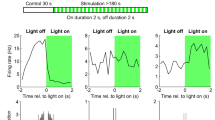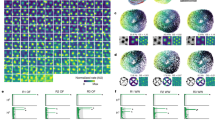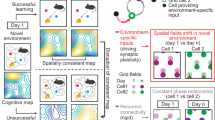Abstract
Grid cells in the medial entorhinal cortex (MEC) generate metric spatial representations. Recent attractor-network models suggest an essential role for GABAergic interneurons in the emergence of the grid-cell firing pattern through recurrent inhibition dependent on grid-cell phase. To test this hypothesis, we studied identified parvalbumin-expressing (PV+) interneurons that are the most likely candidate for providing this recurrent inhibition onto grid cells. Using optogenetics and tetrode recordings in mice, we found that PV+ interneurons exhibited high firing rates, low spatial sparsity and no spatial periodicity. PV+ interneurons inhibited all functionally defined cell types in the MEC and were in turn recruited preferentially by grid cells. To our surprise, we found that individual PV+ interneurons received input from grid cells with various phases, which most likely accounts for the broadly tuned spatial firing activity of PV+ interneurons. Our data argue against the notion that PV+ interneurons provide phase-dependent recurrent inhibition and challenge recent attractor-network models of grid cells.
This is a preview of subscription content, access via your institution
Access options
Subscribe to this journal
Receive 12 print issues and online access
$209.00 per year
only $17.42 per issue
Buy this article
- Purchase on Springer Link
- Instant access to full article PDF
Prices may be subject to local taxes which are calculated during checkout







Similar content being viewed by others
References
Hafting, T., Fyhn, M., Molden, S., Moser, M.-B. & Moser, E.I. Microstructure of aspatial map in the entorhinal cortex. Nature 436, 801–806 (2005).
Taube, J.S., Muller, R.U. & Ranck, J. Jr. Head-direction cells recorded from the postsubiculum in freely moving rats. I. Description and quantitative analysis. J. Neurosci. 10, 420–435 (1990).
O'Keefe, J. & Nadel, L. The Hippocampus as a Cognitive Map (Oxford University Press, Oxford, 1978).
Morris, R.G., Garrud, P., Rawlins, J.N. & O'Keefe, J. Place navigation impaired in rats with hippocampal lesions. Nature 297, 681–683 (1982).
Sargolini, F. et al. Conjunctive representation of position, direction, and velocity in entorhinal cortex. Science 312, 758–762 (2006).
Solstad, T., Boccara, C.N., Kropff, E., Moser, M.-B. & Moser, E.I. Representation of geometric borders in the entorhinal cortex. Science 322, 1865–1868 (2008).
Jones, R.S. & Bühl, E.H. Basket-like interneurones in layer II of the entorhinal cortex exhibit a powerful NMDA-mediated synaptic excitation. Neurosci. Lett. 149, 35–39 (1993).
Wouterlood, F.G., Härtig, W., Brückner, G. & Witter, M.P. Parvalbumin-immunoreactive neurons in the entorhinal cortex of the rat: localization, morphology, connectivity and ultrastructure. J. Neurocytol. 24, 135–153 (1995).
Miettinen, M., Koivisto, E., Riekkinen, P. & Miettinen, R. Coexistence of parvalbumin and GABA in nonpyramidal neurons of the rat entorhinal cortex. Brain Res. 706, 113–122 (1996).
Varga, C., Lee, S.Y. & Soltesz, I. Target-selective GABAergic control of entorhinal cortex output. Nat. Neurosci. 13, 822–824 (2010).
Canto, C.B., Wouterlood, F.G. & Witter, M.P. What does the anatomical organization of the entorhinal cortex tell us? Neural Plast. 2008, 381243 (2008).
Soriano, E., Martinez, A., Farinas, I. & Frotscher, M. Chandelier cells in the hippocampal formation of the rat: the entorhinal area and subicular complex. J. Comp. Neurol. 337, 151–167 (1993).
Burgess, N., Barry, C. & O'Keefe, J. An oscillatory interference model of grid cell firing. Hippocampus 17, 801–812 (2007).
Zilli, E.A. & Hasselmo, M.E. Coupled noisy spiking neurons as velocity-controlled oscillators in a model of grid cell spatial firing. J. Neurosci. 30, 13850–13860 (2010).
Kropff, E. & Treves, A. The emergence of grid cells: intelligent design or just adaptation? Hippocampus 18, 1256–1269 (2008).
McNaughton, B.L., Battaglia, F.P., Jensen, O., Moser, E.I. & Moser, M.-B. Path integration and the neural basis of the 'cognitive map'. Nat. Rev. Neurosci. 7, 663–678 (2006).
Fuhs, M.C. & Touretzky, D.S. A spin glass model of path integration in rat medial entorhinal cortex. J. Neurosci. 26, 4266–4276 (2006).
Burak, Y. & Fiete, I.R. Accurate path integration in continuous attractor network models of grid cells. PLoS Comput. Biol. 5, e1000291 (2009).
Domnisoru, C., Kinkhabwala, A.A. & Tank, D.W. Membrane potential dynamics of grid cells. Nature 495, 199–204 (2013).
Schmidt-Hieber, C. & Häusser, M. Cellular mechanisms of spatial navigation in the medial entorhinal cortex. Nat. Neurosci. 16, 325–331 (2013).
Couey, J.J. et al. Recurrent inhibitory circuitry as a mechanism for grid formation. Nat. Neurosci. 16, 318–324 (2013).
Pastoll, H., Solanka, L., van Rossum, M.C.W. & Nolan, M.F. Feedback inhibition enables theta-nested gamma oscillations and grid firing fields. Neuron 77, 141–154 (2013).
Dhillon, A. & Jones, R.S. Laminar differences in recurrent excitatory transmission in the rat entorhinal cortex in vitro. Neuroscience 99, 413–422 (2000).
Bonnevie, T. et al. Grid cells require excitatory drive from the hippocampus. Nat. Neurosci. 16, 309–317 (2013).
Cardin, J.A. et al. Driving fast-spiking cells induces gamma rhythm and controls sensory responses. Nature 459, 663–667 (2009).
Fuchs, E.C. et al. Recruitment of parvalbumin-positive interneurons determines hippocampal function and associated behavior. Neuron 53, 591–604 (2007).
Nagel, G. et al. Channelrhodopsin-2, a directly light-gated cation-selective membrane channel. Proc. Natl. Acad. Sci. USA 100, 13940–13945 (2003).
Soriano, P. Generalized lacZ expression with the ROSA26 Cre reporter strain. Nat. Genet. 21, 70–71 (1999).
McCormick, D.A., Connors, B.W., Lighthall, J.W. & Prince, D.A. Comparative electrophysiology of pyramidal and sparsely spiny stellate neurons of the neocortex. J. Neurophysiol. 54, 782–806 (1985).
Csicsvari, J., Hirase, H., Czurko, A. & Buzsáki, G. Reliability and state dependence of pyramidal cell-interneuron synapses in the hippocampus: an ensemble approach in the behaving rat. Neuron 21, 179–189 (1998).
Marshall, L. et al. Hippocampal pyramidal cell-interneuron spike transmission is frequency dependent and responsible for place modulation of interneuron discharge. J. Neurosci. 22, RC197 (2002).
Maurer, A.P., Cowen, S.L., Burke, S.N., Barnes, C.A. & McNaughton, B.L. Phase precession in hippocampal interneurons showing strong functional coupling to individual pyramidal cells. J. Neurosci. 26, 13485–13492 (2006).
Stensola, H. et al. The entorhinal grid map is discretized. Nature 492, 72–78 (2012).
Atallah, B.V., Bruns, W., Carandini, M. & Scanziani, M. Parvalbumin-expressing interneurons linearly transform cortical responses to visual stimuli. Neuron 73, 159–170 (2012).
Zariwala, H.A. et al. Visual tuning properties of genetically identified layer 2/3 neuronal types in the primary visual cortex of cre-transgenic mice. Front. Syst. Neurosci. 4, 162 (2011).
Kato, H.K., Gillet, S.N., Peters, A.J., Isaacson, J.S. & Komiyama, T. Parvalbumin-expressing interneurons linearly control olfactory bulb output. Neuron 80, 1218–1231 (2013).
Miyamichi, K. et al. Dissecting local circuits: parvalbumin interneurons underlie broad feedback control of olfactory bulb output. Neuron 80, 1232–1245 (2013).
Royer, S. et al. Control of timing, rate and bursts of hippocampal place cells by dendritic and somatic inhibition. Nat. Neurosci. 15, 769–775 (2012).
Giocomo, L.M., Moser, M.-B. & Moser, E.I. Computational models of grid cells. Neuron 71, 589–603 (2011).
Boccara, C.N. et al. Grid cells in pre- and parasubiculum. Nat. Neurosci. 13, 987–994 (2010).
Klugmann, M. et al. Aav-mediated hippocampal expression of short and long homer1 proteins differentially affect cognition and seizure activity in adult rats. Mol. Cell. Neurosci. 28, 347–360 (2005).
Allen, K., Fuchs, E.C., Jaschonek, H., Bannerman, D.M. & Monyer, H. Gap junctions between interneurons are required for normal spatial coding in the hippocampus and short-term spatial memory. J. Neurosci. 31, 6542–6552 (2011).
Sirota, A. et al. Entrainment of neocortical neurons and gamma oscillations by the hippocampal theta rhythm. Neuron 60, 683–697 (2008).
Skaggs, W.E., McNaughton, B.L., Wilson, M.A. & Barnes, C.A. Theta phase precession in hippocampal neuronal populations and the compression of temporal sequences. Hippocampus 6, 149–172 (1996).
Meyer, A.H., Katona, I., Blatow, M., Rozov, A. & Monyer, H. In vivo labeling of parvalbumin-positive interneurons and analysis of electrical coupling in identified neurons. J. Neurosci. 22, 7055–7064 (2002).
Slezak, M. et al. Transgenic mice for conditional gene manipulation in astroglial cells. Glia 55, 1565–1576 (2007).
Acknowledgements
We thank E. Savenkova and U. Amtmann for their technical assistance, W. Kelsch for providing help at initial stages of the study, M. Michael for immunohistochemical work, and P. Latuske for help with pilot experiments. This work was supported by a Humboldt Research Fellowship for Postdoctoral Studies and a grant from the Innovation Fund FRONTIER of Heidelberg University to K.A., a grant from the European Research Council Advanced Grant (Proposal number 250047) to H.M., and a grant from the German Ministry for Education and Research (BMBF, 01GQ1003A).
Author information
Authors and Affiliations
Contributions
C.B., K.A. and H.M. designed the experiments and wrote the manuscript. C.B. and K.A. performed in vivo electrophysiological experiments. C.B and K.A. analyzed the data.
Corresponding author
Ethics declarations
Competing interests
The authors declare no competing financial interests.
Supplementary information
Supplementary Text and Figures
Supplementary Figures 1–10 (PDF 10831 kb)
Source data
Rights and permissions
About this article
Cite this article
Buetfering, C., Allen, K. & Monyer, H. Parvalbumin interneurons provide grid cell–driven recurrent inhibition in the medial entorhinal cortex. Nat Neurosci 17, 710–718 (2014). https://doi.org/10.1038/nn.3696
Received:
Accepted:
Published:
Issue Date:
DOI: https://doi.org/10.1038/nn.3696
This article is cited by
-
Subfield-specific interneuron circuits govern the hippocampal response to novelty in male mice
Nature Communications (2024)
-
Local origin of excitatory–inhibitory tuning equivalence in a cortical network
Nature Neuroscience (2024)
-
Disruption of the grid cell network in a mouse model of early Alzheimer’s disease
Nature Communications (2022)
-
Right entorhinal cortical thickness is associated with Mini-Mental State Examination scores from multi-country datasets using MRI
Neuroradiology (2022)
-
Perineuronal nets stabilize the grid cell network
Nature Communications (2021)



